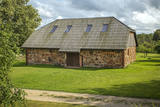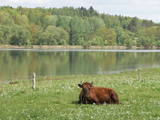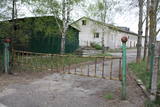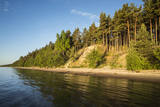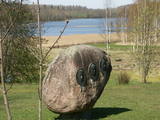| Nr | Name | Beschreibung |
|---|---|---|
|
One of the loveliest apple orchards in Latvia (~10 ha, 30 types of apples) is on the sides of impressive hillocks. During clear weather, you can see the Bay of Rīga from atop the hillocks. The farm is particularly beautiful when apple trees are in bloom. Apples are available for tastings and purchase. |
||
|
This is on the north-western shore of Lake Lielezers of Limbaži, at the start of the Lielezers nature trail. The tower opens up a view of the lake and its lovely shores. It is worth walking the trail, which is several kilometres long, because it is an interesting one. This is part of the ZBR. |
||
|
One of the 15 semi-estates of the former Dundaga Castle, Vecmuiža, has a private collection of historical materials. |
||
|
Der Naturpark im Tal der Daugava ist der einzige Ort zwischen den Kaskaden der Wasserkraftwerke, wo man noch die Chance hat, das Flusstal der Daugava und die Schluchten der Nebenflüsse so zu sehen, wie sie waren, bevor das Gebiet geflutet und die Kraftwerke gebaut wurden. Einen besonders schönen Blick hat man vom rechten Flussufer in der Nähe von Kirche und Burgberg von Aizkraukle. Wälder, Wiesen, Flussquellen und kleine Dolomitfelsen sind in dieser Region alles geschützte Biotope. Freizeitangebote gibt es auf dem Burgberg von Aizkraukle, die Schloßruinen von Aizkraukle sind nicht weit entfernt.
|
||
|
Auch heutzutage wird teilweise der Komplex der Küstengrenzwache von Pape für die Bedürfnissen der lettischen Grenzwachendienstes genutzt.
|
||
|
This is an unusually shaped pine which, according to legend, was planted by the king of Sweden during the Great Northern War.
|
||
|
Der Turm wurde am 27. Juni 1941 in der Zeit eines Luftangriffes der sowjetischen Armee zerstört und 1954 von den Sappeuren der Sowjetarmee in die Luft gesprengt. Die Renovierung der gebliebenen Reste des Turmes hat 2009 angefangen. Im erneuerten Turm ist ein schönes interaktives Museum (Kinderfreundlich), ein Besucherzentrum und einne Glassaussichtsplattform eingerichtet. Ein Restaurant. |
||
|
Im Tagliliengarten kann man Sorten des weltweit berühmten Züchters dieser Blumen V. Baņģiers besichtigen und kaufen. Insgesamt gibt es in dem Garten über 1000 Sorten Taglilien zu sehen und zu kaufen! Der Besuch des Gartens ist in der Blütezeit der Taglilien im Juli und August möglich und kostenlos, täglich von 9 bis 19 Uhr. Zur Verkostung wird der hausgemachte Wein „Vējkalnietis“ angeboten. |
||
|
Atrodas Ventspils Rātslaukuma rietumu pusē iepretim Nikolaja luterāņu baznīcai. Ēkas pirmsākumi ir meklējami 18. gs. 1850. g. tajā atradās pilsētas Rātsnams, kopš 2006. g. - rakstnieku un tulkotāju māja, kurā patstāvīgi uzturas un strādā Latvijas un ārvalstu literāti. |
||
|
Die Steilküste von Ēvaži – bis zu der 8-15 Meter hohen Steilküste führt der 0,3
km lange Pfad, an dessen Ende man einen der schönsten kurländischen Anblicke
auf die Bucht von Riga hat.
|
||
|
Dieses Gebiet wurde errichtet, um die kulturellen und Seelandschaften des zentralen Bereiches des Vizemer Hochlandes mit den Seen Alauksts, Inesis, Tauns, etc. und mit ihren Arten und Biotopen zu schützen. In diesem Territorium sind viele wichtige Kulturobjekte – in Vecpiebalga die lutherische Kirche, die Schloßruinen, der Gutshof, sowie die Orte, wo verschiedene bedeutende Personen des lettischen Kulturlebens gelebt und gearbeitet haben. Museen wurden eingerichtet, um ihrer zu gedenken. Die Seen sind großartig zum Angeln geeignet und Skilaufwettbewerbe werden traditionell im Seengebiet von Alauksts im Winter organisiert. Das Sproģi Naturreservat wurde auf den Inseln und Halbinseln des Sees Inesis eingerichtet.
|
||
|
Atrodas Valmieras Drāmas teātra ēkas rietumu spārnā. Piedāvā latviešu un pasaules virtuvi, svētdienās - brančus. Sadarbojas ar vietējām zemnieku saimniecībām. |
||
|
The workshop offers a look at lanterns, candelabras, hinges, fireplace tools, stair railings and gates that have been manufactured there, as well as several exhibits from the 18th century. You can produce your own nail, and the blacksmith will also “test” young couples. He also accepts orders for products. |
||
|
Auf dem Bauernmarkt Lõunakeskus werden die in Estland angebauten und mit den örtlichen Produkten zubereiteten Lebensmittel sowohl für den Alltag als auch den Festtagstisch verkauft. Die vielfältigen Produkte stammen hauptsächlich von den südestnischen Betrieben, man kann aber auch Waren anderer Regionen Estlands dort finden. Es gibt auch ein gemütliches Café, in dem Sie mit den auf dem Markt angebotenen frischen Produkten zubereitete Speisen genießen können. |
||
|
Divarpus kilometrus gara taka (vienā virzienā) aizved līdz Hallistes palieņu pļavām, kur Hallistes upes labajā krastā ir uzcelts divstāvīgs koka skatu tornis. No tā paveras visaptverošs skats uz atjaunotajām (izcirsti krūmi) Hallistes palieņu pļavām. Pavasara palu laikā no torņa redzamā apkārtne un tornis atrodas ūdenī. |
||
|
Die Bauernwirtschaft Kaigari befindet sich in der Gemeinde Mežotne der Region Bauska. Sie ist auf die Züchtung von Samen der Getreidepflanzen spezialisiert. In der Wirtschaft werden aktiv die Möglichkeiten der EU-Projekte genutzt, die geholfen haben, moderne landwirtschaftliche Produktionstechnik zu kaufen. Insgesamt werden ungefähr 400 ha bewirtschaftet. Aus dem Apfelbaumgarten der Wirtschaft bietet sich eine wunderbare Aussicht auf das Tal des Flusses Lielupe. |
||
|
Līdz 18. gs. šajā vietā bija koka baznīca, kamēr 1798. g. uzcēla mūra baznīcu, kas cieta 1. pasaules karā, bet 2. pasaules kara laikā to uzspridzināja. Tikai pusgadsimtu vēlāk - 1991. gadā tika uzsākti atjaunošanas darbi, kas joprojām turpinās. Tagad redzamais dievnams ir iepriekšējā līdzinieks. |
||
|
Auf den 2 ha der Bauernwirtschaft "Lielkalni" werden seit 2006 ungewöhnliche Beerensträucher gepflanzt: Gold-Johannisbeeren, Drosselbeeren, Lamberthaseln, Sanddorn, Schwarze Holunder, Chinesisches Spaltkörbchen, Scharfzähnige Strahlengriffel, Essbare Geißblätter u.a. Seit 2008. ist die Bauernwirtschaft als biologische Landwirtschaft zertifiziert. 2009. wurde das Gesundheits- und Veterinärdienstzertifikat erhalten. Die Eigentümer haben angefangen gesundheitsstärkende Sirupe, Gelees, Konfitüre und Tees zu fertigen und zu verkaufen. Die Besucher können verschiedene Teesorten, saisonale Beeren, Sirupe, Gelees und andere Leckerbissen probieren und sie auch für sich zulegen.
|
||
|
Ložmetējkalns Hill is one of the highest locations at the Long Dune. There is a monument to heroic Latvian riflemen who suffered great losses here during the Christmas battles of late 1916. There is a great view of forests all the way to Jūrmala, as well as of the Maztīrelis swamp, where the embankment of the former narrow-gauge railroad is very evident. This is part of a memorial park to commemorate the Christmas battles. You can visit the Mangaļi museum, the restored “German Rampart,” monuments and other objects.
|
||
|
Diese Reise wird Ihnen die Vielfalt der Landwirtschaft der Region Kurzeme und deren Erzeugnisse offenbaren. Schmackhaft und interessant! Die Stadt Rīga hinter sich gelassen, führt die Strecke der Ostseebucht entlang durch Fischerdörfer, in denen es verführerisch nach geräuchertem Fisch riecht. Auf dem Weg nach Talsi halten Sie an einem Apfelgarten und Bauernhof, wo Chips aus lettischen Äpfeln hergestellt werden. Die Stadt Talsi ist nicht nur als eine Stadt auf 9 Hügeln, sondert auch als der Ort bekannt, wo der köstliche Käse «Talsu ritulis» (Talsi-Scheibe) hergestellt wird. Hier befindet sich das Landwirtschaftsmuseum Lettlands, in dem Sie alles über das Leben auf dem Lande vom 19. Jahrhundert bis heute erfahren können. Die Wahrzeichen der Stadt Kuldīga sind die Brücke aus rotem Backstein über den Fluss Venta und die charmante Altstadt. Danach verläuft die Strecke weiter der Meeresküste entlang. Dort werden Ihnen die Traditionen des Fischfanges, der Fischräucherei und des Brotbackens nahegebracht. Erfreuen wird sich Ihr Auge auch an der einzigartigen Steilküste in Jūrkalne. Auf dem Rückweg lohnt die Einkehr in ein Weingut und eine Landwirtschaft, wo Shiitake-Pilze gezüchtet werden. Auch werden Sie den Werdegang der Milch vom Melken einer Kuh bis hin zum fertigen Milchprodukt erleben. Darüber hinaus besuchen Sie einen Bauernhof, dessen Familiengeschichte bis auf die Zeiten der Herzöge und Gutshöfe zurückgeht. |
||


